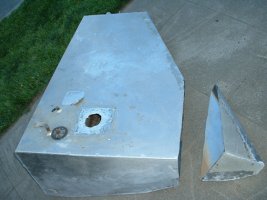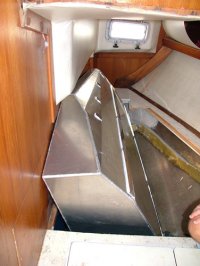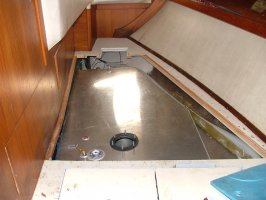fuel tank removal.....
The picture below shows how got my tank out. The tank had a pinhole leak from corrosion. Ericson didnt do a very good installation job and water stayed trapped under the tank.
When I removed the tank I found that it wouldnt fit through the companionway. Not suprising since its all done before the deck is put on. Quick measurement and the sawzall got it out with 1/4 inch to spare. Went to get it repaired and the tank guy reminded me that I would be re installing an "old" repaired tank. Convinced me to have a new one built, so $700 bucks later I had a much stronger, better baffeled tank that would fit through the hatch.
Since Ericson didnt bother to degrease the original tank, all the fiberglass tabbing to secure the tank had let go. This was a good thing as it left a perfect cradle to hold the new tank in place. I used 5200 to bond 1/4 inch lexan strips to the bottom of the tank so water won't be in contact, as well as making sure there were drain holes to let the water get past the tabbing.
Was expensive but now I will never worry about the condition of the tank. Besides having the tank cleaned and repaired was going to be $350. I also know it's installed correctly and will fit through the hatch if needed.
I filled the part of the tank I cut off with water and it measured 1.5 gallons. The tank still holds 52 gallons so I dont think I will miss it.
BTW the Tank access ports mentioned in the previous post are VERY high quality. Mine was expensive but I'm pretty sure it will never leak. I had a simple float gauge installed with the mechanical dial on top of the tank. The electric one was always a problem and I didnt trust it.






